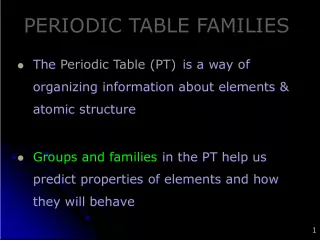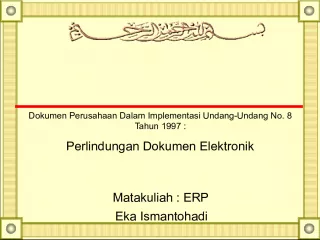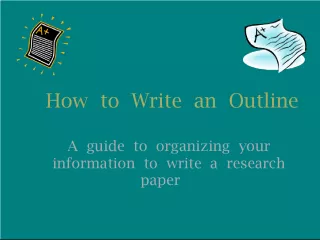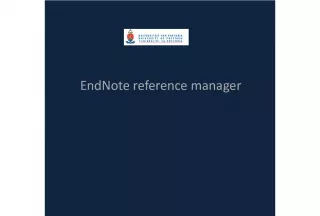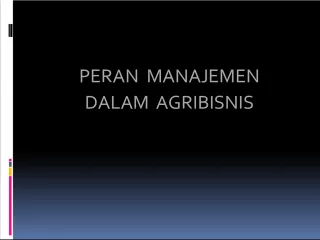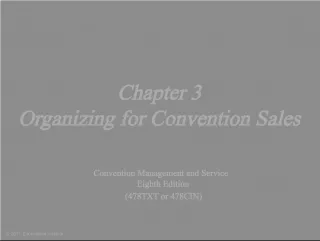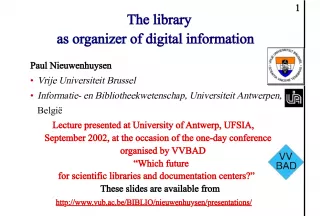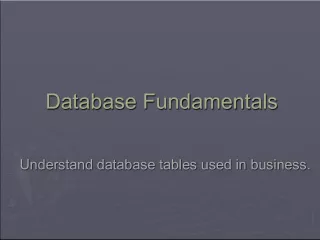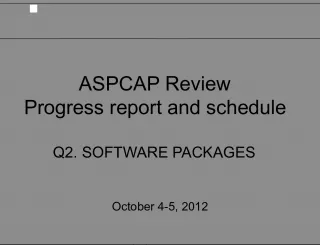What Is Organizing?
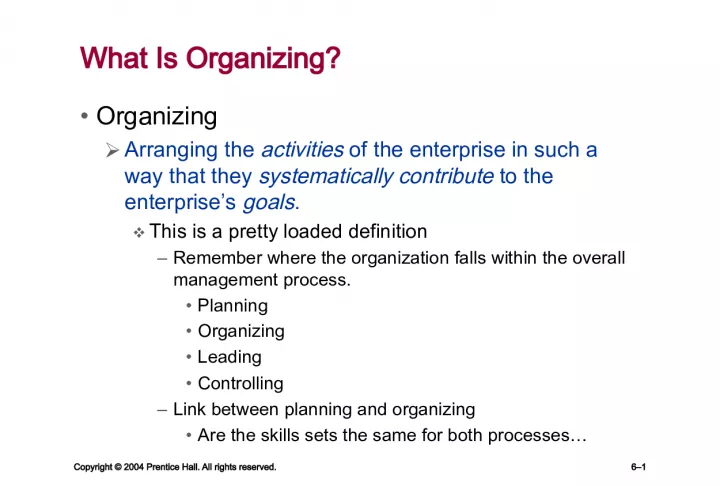

This passage explores the definition of organizing, which involves arranging the activities of a business in a way that systematically contributes to achieving its goals. The passage emphasizes the importance of understanding where organizing falls within the overall management
- Uploaded on | 1 Views
-
 nuno
nuno
About What Is Organizing?
PowerPoint presentation about 'What Is Organizing?'. This presentation describes the topic on This passage explores the definition of organizing, which involves arranging the activities of a business in a way that systematically contributes to achieving its goals. The passage emphasizes the importance of understanding where organizing falls within the overall management. The key topics included in this slideshow are . Download this presentation absolutely free.
Presentation Transcript
Slide1copyright © 2004 prentice hall. all rights reserved.6–1 What Is Organizing? • Organizing Arranging the activities of the enterprise in such a way that they systematically contribute to the enterprise’s goals . This is a pretty loaded definition – Remember where the organization falls within the overall management process. • Planning • Organizing • Leading • Controlling – Link between planning and organizing • Are the skills sets the same for both processes…
Slide2copyright © 2004 prentice hall. all rights reserved.6–2 Depicting the Organization • Organization Chart A chart that shows the structure of the organization including: Strategy Structure – The title of each manager and position • Legitimacy – Connecting lines • Formal networks / communication – Accountability • Stipulated, not perceived – Authority • Formal right to take action The organizational chart is one of the most popular ways to “organize” strategic planning. – It is inherently important that the strategy and structure fit
Slide3copyright © 2004 prentice hall. all rights reserved.6–3 Authority and the Chain of Command • Chain of Command The path that a directive and/or answer or request should take through each level of an organization. – Above and beyond authority – Chain of command ensures the proper communication and delivery of confidential information • Authority The right to take action, to make decisions, and to direct the work of others. – Legitimized through structure and position – Earned through action – Leadership theories
Slide4copyright © 2004 prentice hall. all rights reserved.6–4 Line and Staff Authority • Line Manager A manager who is: (1) in charge of essential activities such as sales (2) authorized to issue orders to subordinates down the chain of command. • Staff Manager A manager without the authority to give orders down the chain of command (except in his or her own department) Generally can only assist and advise line managers in specialized areas such as human resources management.
Slide5copyright © 2004 prentice hall. all rights reserved.6–5 Line and Staff Authority • Functional Authority Narrowly limited power to issue orders down the chain of command in a specific functional area. In respect to other types of authority: – Functional authority refers to legitimacy and authority based on the perceived expert knowledge the one has on a specific area. Other areas of authority may come from: – Divisional expertise – Product – Organziational
Slide6copyright © 2004 prentice hall. all rights reserved.6–6 The Informal Organization Informal Organization The informal contacts, communications, and habitual ways of doing things that employees develop. More common in today’s environment 3 areas Contacts Communications Habits / Behavior Remember, both of these organization exist simultaneously. The question is which has more influence and power
Slide7copyright © 2004 prentice hall. all rights reserved.6–7 Departmentalization: • Departmentalization The process through which an organization’s activities are grouped together and assigned to managers. One of the fundamental approaches to organization – In essence, grouping people with like professional backgrounds together – In an effort to bring about increased production and efficiency – This also allows for better control and managing of employees within the organization But, since your in my class you know better – What are the down-sides in relation to present day
Slide8copyright © 2004 prentice hall. all rights reserved.6–8 Organizing Departments by Function • Functional Departmentalization A form of organization that groups a company’s activities around essential functions such as manufacturing, sales, or finance. Again the major benefit is in the control – Very homogeneous and predictable subgroup – Efficiencies Drawbacks – Lack of creativity – Lack of adaptability – Higher need for formal coordination throughout the orgainiztion
Slide9copyright © 2004 prentice hall. all rights reserved.6–9 Self-Contained Divisions/Purposes • Product Departmentalization Grouping departments around a firm’s products or services, or each family of products or services; also referred to as a “divisional” organization. This is important when the product is the organization – You can pool functional resources into one division to ensure maximum effectiveness – Insulated • Customer Departmentalization Self-contained departments are organized to serve the needs of specific groups of customers. – Niche markets – Overseas markets
Slide10copyright © 2004 prentice hall. all rights reserved.6–10 Divisional Organization for a Pharmaceuticals Company FIGURE 6–2
Slide11copyright © 2004 prentice hall. all rights reserved.6–11 FIGURE 6–3 Customer Departmentalization, Grayson Steel Company
Slide12copyright © 2004 prentice hall. all rights reserved.6–12 Organizing Departments by Self- Contained Divisions/Purposes (cont’d) • Marketing-channel Departmentalization Departments focus on particular marketing channels, such as drugstores or grocery stores. • Geographic (Territorial) Departmentalization Separate departments are established for each of the territories in which the enterprise does business. • In the end: Organization need to decide what structure best suits external effectiveness and internal efficiency
Slide13copyright © 2004 prentice hall. all rights reserved.6–13 FIGURE 6–4 Marketing Channel Departmentalization
Slide14copyright © 2004 prentice hall. all rights reserved.6–14 FIGURE 6–5 Divisional Organizations Facilitate Coordination
Slide15copyright © 2004 prentice hall. all rights reserved.6–15 Checklist 6.1 Functional vs. Divisional Organizations Functional Organization Advantages 1. It is simple, obvious, and logical. 2. It fosters efficiency. 3. It can simplify executive hiring and training. 4. It can facilitate the top manager’s control. Functional Organization Disadvantages 1. It increases the workload on the executive to whom the functional department heads report. 2. It may reduce the firm’s sensitivity to and service to the customer. 3. It produces fewer general managers.
Slide16copyright © 2004 prentice hall. all rights reserved.6–16 Checklist 6.1 (cont’d) Functional vs. Divisional Organizations Divisional Organization Advantages 1. The product or service gets the single-minded attention of its own general manager and unit, and its customers may get better, more responsive service. 2. It’s easier to judge performance. 3. It develops general managers. 4. It reduces the burden for the company’s CEO. Divisional Organization Disadvantages 1. It creates duplication of effort. 2. It may diminish top management’s control. 3. It requires more managers with general management abilities. 4. It can breed compartmentalization.
Slide17copyright © 2004 prentice hall. all rights reserved.6–17 Creating Matrix Organizations • Matrix Organization An organization structure in which employees are: Permanently attached to one department But also simultaneously engaged in ongoing assignments in which they report to: – Project – Customer – Product – Geographic unit heads. Obviously, we need a hybrid (all-in-one) approach to address all the other types of structures available Hence the matrix organization
Slide18copyright © 2004 prentice hall. all rights reserved.6–18 FIGURE 6–6 Matrix Organization Departmentalization
Slide19copyright © 2004 prentice hall. all rights reserved.6–19 Matrix Organizations Advantages • Access to expertise. • Stability of permanent department assignments for employees. • Allows for focus on specific projects, products, or customers. Disadvantages • Confusion of command. • Power struggles and conflicts. • Lost time in coordinating. • Excess overhead for managing matrix functions.
Slide20copyright © 2004 prentice hall. all rights reserved.6–20 Departmentalization in Practice: A Hybrid • Why mix the types of departmentalization? Hierarchical considerations The relationship of top level departments to their subsidiary departments. Efficiency Product, customer, and territorial departments tend to result in duplicate sales, manufacturing, and other functional departments. Common sense Departmentalizing is still more an art than a science.
Slide21copyright © 2004 prentice hall. all rights reserved.6–21 Tall And Flat Organizations, And The Span Of Control • Span of Control The number of subordinates reporting directly to a supervisor. Wide spans: larger number of direct reports. Narrow spans: fewer number of direct reports. • Tall vs. Flat Organizations Tall organizations: more management layers and more hierarchical controls. Flat organizations: fewer management layer and decision making closer to the customer.
Slide22copyright © 2004 prentice hall. all rights reserved.6–22 Network-based Organizations • Organizational Network A system of interconnected or cooperating individuals. How is this different from structure? What is the base premise? Do networks fall in line with structures? • Informal Networks Communication pathways and relationships between individuals in an organization that Do not necessarily conform to the formal chain of command and communication networks of an organization.
Slide23copyright © 2004 prentice hall. all rights reserved.6–23 Network-based Organizations (cont’d) • Formal Organizational Network A recognized group of managers or other employees Assembled by the CEO and the other senior executive team Drawn from across the company’s functions, business units, geography, and levels. – Why would you need this given structure? • Electronic Organizational Networks Networking through technology-supported devices such as E-mail Video-conferencing Collaborative computing
Slide24copyright © 2004 prentice hall. all rights reserved.6–24 FIGURE 6–10 How Networks Reshape Organizations Where is the control and authority? Where does the organization come from?
Slide25copyright © 2004 prentice hall. all rights reserved.6–25 Network-based Organizations (cont’d) • Team-Based Organizations Team A group of people committed to a common purpose, set of performance goals, and approach for which they hold themselves mutually accountable. • Horizontal Corporations A structure that is organized around customer- oriented processes performed by: Multidisciplinary cross-functional teams rather than by formal functional departments. In this manner, the networks and relationships become the control mechanisms.
Slide26copyright © 2004 prentice hall. all rights reserved.6–26 FIGURE 6–11 The Horizontal Corporation Source: Source: John A. Byrne, “The Horizontal Corporation,” Business Week , 20 December 1993, p. 80.
Slide27copyright © 2004 prentice hall. all rights reserved.6–27 Checklist 6.2 Building Horizontal Organizations Make responsibilities overlap. Design individual jobs as broadly as possible, and keep the number of job titles to a minimum. Base rewards on unit performance to emphasize the importance of working together. Change the physical layout to promote collective responsibility. Let people see each other’s work. Redesign work procedures, provide computer terminals, use the e-mail network, and make sure managers are available.
Slide28copyright © 2004 prentice hall. all rights reserved.6–28 FIGURE 6–12 How to Create a Horizontal Corporation Source: Source: Reprinted from the December 20, 1993, issue of Business Week by special permission. Copyright © 1993 by the McGraw-Hill Companies, Inc.
Slide29copyright © 2004 prentice hall. all rights reserved.6–29 Other Organization Types • Virtual Organization A temporary network of independent companies that use information technology to share skills, reduce costs, and provide access to one another’s markets. Its success depends on each of the individual firms’ Responsibility Self-interest to accomplish the network’s purpose. Virtual organizations are highly dependent on: Technologies Individual work ethics Platform controls
